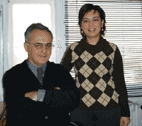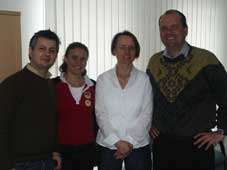Candidate gene- analysis at complicated HSP with thin Corpus Callosum (SPG11)
Applicants:
Dr. med. Gökhan Uyanik 1 Dr. med. Akgün Ölmez 2 Dr. med Beate Winner 1Claudia Groß 3 Dr. med. Ute Hehr 3 Prof. Dr. med. Haluk Topaloglu 2 Prof. Dr. med. Jürgen Winkler 1
1) Klinik und Poliklinik für Neurologie der Universität Regensburg am Bezirksklinikum Email:goekhan.uyanik@klinik.uni-regensburg.de; juergen.winkler@klinik.uni-regensburg.de 2) Abteilung für Neuropädiatrie, Ihsan Dogramaci Kinderklinik der Hacettepe Universität, Sihhiye, 06100 Ankara, Türkei 3) Zentrum für Humangenetik, Hemauerstr. 1, 93047 Regensburg
Summary
Hereditary spastic paraplegias (HSP) or Familial Spastic Paraplegias (FSP) are a heterogeneous group of neurodegenerative diseases affecting the corticospinal tract but also involving the peripheral nervous system and other CNS structures like the corpus callosum. Clinically, there are and complicated forms. The heterogeneity is also reflected by the different forms of inheritance. There are autosomal-dominant, autosomal-recessive and also X-linked inherited forms. Up to date more than 30 different forms of HSPs have been described.
A distinct group of recessively inherited HSPs with thin corpus callosum (HSP-TCC) shows in addition to the spasticity of the lower limbs also a progressive degeneration of the corpus callosum. For SPG11, one form of HSP-TCC, first described in Japanese patients, the locus could be designated to the long arm of chromosome 15, but the “SPG11 gene” could not be identified so far.
Establishing an intensive international collaboration (Germany, Austria, Turkey and Saudi Arabia) we could identify additional families linked to 15q13, the locus of SPG11. The pedigrees with several affected and non-affected family members allowed us to narrow down the SPG11 locus to less than 5 cM.
This study will try to:
1. identify additional families with SPG11 by linkage analysis to increaas the number of affected families
2. finemap the critical region by 100K SNP-chip-analysis
3. identify the altered pathways in SPG11 patients by gene-expression profiling in lymphocytes of patient compared to controls
4. identify the SPG11 gene by candidate gene sequencing within the critical region
We hope that by establishing an intensive collaboration with Prof. Rieß (Human Genetics Tübingen) and Prof. Schöls (Hertie-Institute Tübingen), the careful clinical characterisation of the families and the finemapping of the SPG11 locus we will be able to identify the “SPG11 gene”






